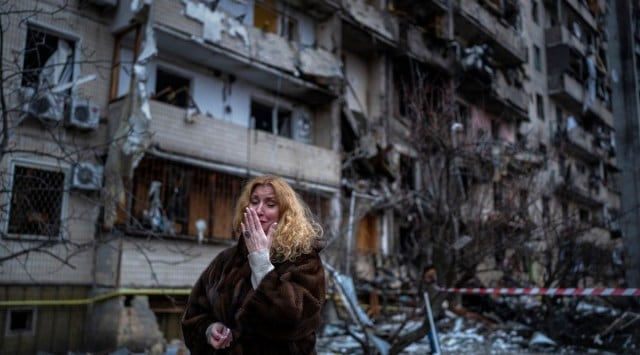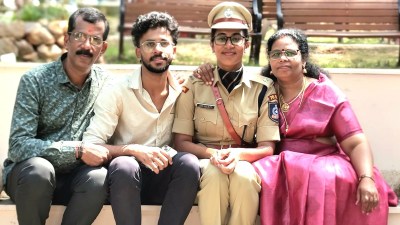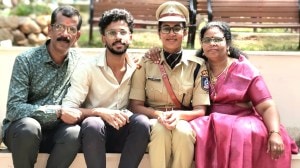Stay updated with the latest - Click here to follow us on Instagram
Russia’s invasion of Ukraine: How world leaders have responded to the war
While fears of a fresh offensive by Russia lurk in Ukrainian minds, the critical question remain: What can the world do to end this war, that, as of now, has displaced over 7.5 million people from Ukraine?
 The yearlong war in Ukraine has left tens of thousands of dead and wounded on both sides, disrupted energy and food supplies, and reduced whole cities to ruins. (AP Photo)
The yearlong war in Ukraine has left tens of thousands of dead and wounded on both sides, disrupted energy and food supplies, and reduced whole cities to ruins. (AP Photo) Neither just a massive show of weapons, nor just that of power — Russia’s war on Ukraine has also been about loss of lives, lingering pain, fear that lurks as military drones crowd the innocent skies, and the differing global responses to the invasion.
Let’s take a look at how Presidents of both the countries — Russia and Ukraine — and global leaders have responded to the war that has continued over the past year.
United States
Just days before what would mark an year to Russia’s invasion of Ukraine, United States President Joe Biden made an unannounced visit to Ukraine to meet President Volodymyr Zelenskyy, in a firm gesture of solidarity. Biden, during his visit, recalled his conversation with the latter on the night of the invasion and said, “That dark night one year ago, the world was literally at the time bracing for the fall of Kyiv. Perhaps even the end of Ukraine.” A year later on February 20, he said, “Ukraine stands. Democracy stands. The Americans stand with you, and the world stands with you,” according to news agency AP.
 A general view shows a building damaged by a Russian military strike, amid Russia’s attack on Ukraine, in the front line city of Vuhledar, Ukraine on February 22, 2023. (Photo: Reuters)
A general view shows a building damaged by a Russian military strike, amid Russia’s attack on Ukraine, in the front line city of Vuhledar, Ukraine on February 22, 2023. (Photo: Reuters)
With the war expected to escalate in the coming days, Biden’s recent visit suggests his move towards keeping Western allies intact in their support towards Ukraine. According to AP, the US President this time announced half-billion dollars in assistance to Ukraine, in addition to the more than $50 billion that has been already provided by his country — including shells for howitzers, anti-tank missiles, air surveillance radars among other aid. Significantly, the US also provided the M142 High Mobility Artillery Rocket System or HIMARS, reported to have assisted Ukraine recapture Kherson last November.
Moreover, America recently announced that it will supply 31 M1 Abrams tanks, known as the first to be delivered to its forces in 1980. According to an AP report, the powerful jet engine of the Abrams is equipped to “propel the tank through almost any terrain, whether heavy snow or heavy mud.”
Biden’s act of defiance against the Russian President Vladimir Putin seemingly led the latter to deliver a nuclear warning to the West the following day. On Tuesday, Russia suspended the New START Treaty — the last major nuclear arms control treaty between Moscow and Washington, and announced a new strategic systems on combat duty. Moreover, accusing the West of making attempts to destroy Russia, he warned that Moscow could resume nuclear tests. “Of course, we will not do this first. But if the United States conducts tests, then we will,” the Russian President said.
While Putin continues to allege that the war was forced upon his country, the West and the to-be NATO member Ukraine assert that the expansion of the North Atlantic Treaty Organization eastwards provide little justification for the brutality caused by Russia.
Soon after Russia attacked parts of Ukraine last year, Zelenskyy, during his first address to the House and the Senate in the month of March related to the war, made urgent appeals to the world to assist his country in its battle against Russia. Describing it as the “worst war since World War II,” he said, “we are asking for a reply, for an answer to this terror from the whole world.” He sought US’ support to close the skies over Ukraine and “pleaded with NATO allies to impose a no-fly zone — a move the allies have said would essentially begin World War III” — but has been spurned, according to The New York Times.
 Ukrainian soldiers fire at Russian positions from a U.S.-supplied M777 howitzer in Ukraine’s Kherson region on Jan. 9, 2023. (AP Photo/File)
Ukrainian soldiers fire at Russian positions from a U.S.-supplied M777 howitzer in Ukraine’s Kherson region on Jan. 9, 2023. (AP Photo/File)
United Kingdom
Then UK Prime Minister Boris Johnson emerged as one of the staunchest supporters of Ukraine in its efforts to reclaim its lost territories. Last year in April, he met Zelenskyy and pledged tighter sanctions on Russia while offering defensive arms to Ukraine.
The country has so far provided it with 120 armoured vehicles and new anti-ship missile systems, and has announced measures to avoid the use of hydrocarbons. Both Johnson and Zelenskyy had been in conversation since Russia launched its full-scale attack on Ukraine.
The UK condemned the “Russian government’s unprovoked and premeditated war against Ukraine.” It stated, “The UK government is providing a range of economic, humanitarian and defensive military assistance to Ukraine, and is imposing additional sanctions on Russia and Belarus.”
Germany
Germany, after weeks of contemplation and discussions agreed to send advanced state-of-the-art battle tanks to Ukraine. The European nation which was earlier hesitant to give up its pacifist inclinations and reconsider its economic dependence on Russia, announced that it would send 14 Leopard 2 tanks, thereby, aiming to provide a total of two battalions (or 88 tanks) to Ukraine. In the latest development, German chancellor Olaf Scholz and India’s Prime Minister Narendra Modi are set to meet on February 25 to discuss, essentially, the Russia-Ukraine conflict and China’s assertive role in the Indo-Pacific.
 Sophia, 13, stands next to the body of her father Roman, during his funeral in Bila Tserkva, near Kyiv, Ukraine, on Feb. 22, 2023. Roman Shevchenko, 40, was a civilian who joined the Ukrainian Armed Forces to defend his country when the Russian full-scale war started. (AP Photo)
Sophia, 13, stands next to the body of her father Roman, during his funeral in Bila Tserkva, near Kyiv, Ukraine, on Feb. 22, 2023. Roman Shevchenko, 40, was a civilian who joined the Ukrainian Armed Forces to defend his country when the Russian full-scale war started. (AP Photo)
US-led Western allies
Australia, Canada and the US have also helped the country by sending the M777 artillery. While America provided kamikaze — also known as suicide drones — to Ukraine, Turkey contributed to the move with its Bayraktar attack drone.
These forms of assistance, however, are being perceived by Russia as a ‘proxy’ war fought by Ukraine on behalf of the US and the West.
China
In its most recent move to gain support for the war, Russia deepened its ties with China as its relationship with the West reached its lowest point since the Cold War, according to an AP report. Putin hailed this diplomatic move and expressed that the Kremlin expects the Chinese President Xi Jinping to visit Russia. With the shared goal of countering US’ dominance over global state of affairs, both countries entered into a relationship which bears “no limits”. China has repeatedly refused to criticise Russia’s invasion of Ukraine, while Russia has sustained its support in its tensions with the United States over Taiwan.
While China has made its diplomatic relations with Russia and Ukraine explicit, India continues to maintain, what is being referred to as a “strategic” balance, between not condemning the Russian invasion and holding on to its relationship with the US and Europe, which, unlike India, have firmly stated their stance against the war.
 A building damaged by a Russian military strike, amid Russia’s attack on Ukraine, in the front line city of Vuhledar, Ukraine on February 22, 2023. (Photo: Reuters)
A building damaged by a Russian military strike, amid Russia’s attack on Ukraine, in the front line city of Vuhledar, Ukraine on February 22, 2023. (Photo: Reuters)
India
In September last year, President Putin met India’s PM Modi on the sidelines of the Shanghai Cooperation Organisation summit in the Uzbekistan city of Samarkand. While Modi conveyed to the Russian President that “today’s era is not an era of war,” Putin shared that he understood Delhi’s concerns about the conflict in Ukraine and wanted it to end “as soon as possible.” In what stood as the first meeting between the two leaders since the invasion, the discussion focused on furthering India-Russia cooperation in sectors such as trade, energy, food, defence and others. The MEA then released a statement which said, “In the context of the ongoing conflict in Ukraine, Prime Minister reiterated his call for an early cessation of hostilities and the need for dialogue and diplomacy.”
Zelenksyy, last December, in a telephonic conversation with Modi, sought India’s support on the 10-point “peace formula” he had proposed on his visit to US during the month. The formula entailed “withdrawal of Russian troops from Ukraine, release of prisoners, restoration of Ukraine’s territorial integrity and guarantees on nuclear safety, food and energy security,” according to The Indian Express report.
Over the past year, the Ukraine President has reached out to Modi about almost four times. Moreover, in October, after abstaining on a UNSC resolution condemning Moscow’s “illegal referenda” and declared its annexation of four Ukrainian territories as invalid, affirmed that “there can be no military solution” to the conflict and the country was ready to “contribute to any peace efforts”. The Prime Minister’s Office, soon after, releasing a statement, said that “both sides should revert to dialogue and diplomacy to find a lasting solution to their differences.”
India, now, is set to discuss its plans with the German chancellor, who will visit India over the weekend, to seek support to a UN resolution on “Ukraine conflict” that demands “immediate cessation of hostilities and lasting peace in Ukraine.”
 Nina Nikiforovа, 80, cries outside a church in Kyiv, Ukraine, on Feb. 11, 2023, at the funeral of her son Volodymyr, a Ukrainian serviceman who was killed in the eastern part of the country. Some experts warn that the war, which already has killed tens of thousands on both sides and reduced entire cities to ruins, could drag on for years. (AP Photo/File)
Nina Nikiforovа, 80, cries outside a church in Kyiv, Ukraine, on Feb. 11, 2023, at the funeral of her son Volodymyr, a Ukrainian serviceman who was killed in the eastern part of the country. Some experts warn that the war, which already has killed tens of thousands on both sides and reduced entire cities to ruins, could drag on for years. (AP Photo/File)
United Nations
On February 6, United Nations Secretary General Antonio Guterres, in a speech to the UN General Assembly, said, “The prospects for peace keep diminishing … “The chances of further escalation and bloodshed keep growing.”
Last year, as Russian troops entered Ukraine, with the aim of toppling its government, occupying Kyiv and asserting Kremlin’s influence in the region, Guterres had pleaded with Putin to bring back his troops to Russia.
Hungary
Since the time of the invasion, Hungary, a country in Central Europe, has tried to hinder the support of the European Union for Ukraine. In December last year, amidst confusion whether Hungary would veto the bloc’s plan to provide €18 billion loan ($19 billion) to Ukraine, the Hungarian Prime Minister Viktor Orban denied using veto, and said, “This is fake news. […] No veto, no blackmailing.” Sharing a tweet, he confirmed that the country was willing to support Ukraine on a bilateral basis.
1/3 Today’s news was all about Hungary vetoing financial assistance to #Ukraine. This is fake news. Hungary is ready to give financial assistance to Ukraine, on a bilateral basis. No #veto, no blackmailing.
— Orbán Viktor (@PM_ViktorOrban) December 6, 2022
Hungary, being dependent on Russia for its energy supplies, has turned to proving its loyalty towards Moscow more than Ukraine. Orban, in the initial days of the war, was slow to condemn Russian aggression as well as critical of sanctions against it, according to a Deutsche Welle report. He repeatedly called for immediate ceasefires, and also negotiated exemptions on boycott of Russian oil for Hungary.
Now almost after a year, he, according to a report by AP, has accused EU of prolonging the war in Ukraine. While addressing a meeting in Budapest, he said, “The EU had fanned the flames of the war by sanctioning Russia and supplying Ukraine with money and weapons, rather than seeking to negotiate a peace with Moscow,” AP reported.
His remarks indicate his outright stance on the deadly war, where he condemns his Western allies for assisting Ukraine in its war efforts.
Belarus
Last year in October, as the Russian troops were sent back to Belarus, fears of a joint invasion prevailed across Ukraine’s northern border. The Ukrainian army, in response, released a video which bluntly stated, “If the Belarusian army supports Russian aggression, we will respond… with our entire arsenal of weapons.”
 Ukrainian service members ride a BMP-1 infantry fighting vehicle, as Russia’s attack on Ukraine continues, near the frontline town of Vuhledar, Ukraine on February 22, 2023. (Photo: Reuters)
Ukrainian service members ride a BMP-1 infantry fighting vehicle, as Russia’s attack on Ukraine continues, near the frontline town of Vuhledar, Ukraine on February 22, 2023. (Photo: Reuters)
Minsk, the capital of Belarus, and Moscow had then formed a joint “regional group” of forces to protect Belarus from its neighbours, thereby, increasing pressures upon the Belarusian leader Alexander Lukashenko to provide consistent support to Russia.
Most recently, Lukashenko announced that it will form a new “territorial defense force” amid the escalations in neighboring Ukraine, AP reported. The two countries have continued to conduct joint drills in Belarus as part of their military alliance against Ukraine, furthering their ties with each other. According to the report, he said that “every Belarusian man must learn how to handle weapons “to protect his family and home”, in case of aggression.”
While fears of a fresh offensive by Russia lurk in Ukrainian minds, the critical questions remain: What can the world do to end this war, that, as of now, has displaced over 7.5 million people from Ukraine? While the military casualties are unclear yet, civilian casualties have crossed 18,000 over the year, according to the Office of the UN High Commissioner for Human Rights. More importantly, is there an end to this gruesome war?
Photos



- 01
- 02
- 03
- 04
- 05



























